How To Change The File Extension In Windows 10
When we refer to files like MP3s, ZIPs, or PDFs, we're referring to the file type (or file extension) that allows the operating system to place what type of file information technology is and what software is needed to open it. This is how Windows or macOS can determine that an MP3 file needs to be opened by your music actor, or a PDF by a PDF reader.
If the file has the wrong file type, and then Windows volition use the incorrect program to open up information technology. This will probably cause an error and stop you from accessing your file—afterward all, Microsoft Word can't handle MP3s. If you need to figure out how to change file types in Windows 10 the right way, then you'll need to follow these steps.
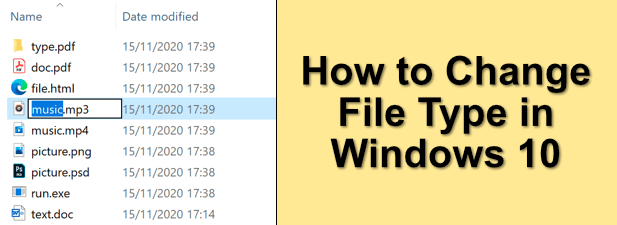
Can You Change File Type in Windows ten?
A file extension acts as a way for Windows to determine what to do with a file. Information technology tells the Windows operating system that, when y'all open an MP4 file, it should open VLC (if it'south installed on your PC). Or when you open a DOCX file, it should open Microsoft Word. For every file type the operating organisation knows, it'll friction match the file extension to software that should be able to open it.
It's possible to alter the file type for files in Windows 10, but this depends on the file itself. Changing file types isn't but about irresolute the extension at the end of a file name. If a file isn't created the "correct way" then but irresolute the extension won't work.

Irresolute the extension doesn't change what the file ultimately is. An MP3 isn't a Word document, so irresolute the file type from MP3 to DOCX won't all of a sudden make Word a music player. However, if the file types are similar (for instance, JPG and PNG), then the software may notwithstanding be able to open the file.
The best way to change file extensions is to save or convert it into an culling format or use conversion services online. If you're confident that the file volition all the same open up, all the same, you lot tin quickly rename the extension using Windows File Explorer instead, just this may not work properly.
Displaying File Extensions in Windows File Explorer
Previous versions of Windows showed the file extension for files in Windows File Explorer. In Windows 10, these extensions are hidden past default, preventing you from speedily changing the file type.
If you want to change file extensions using Windows File Explorer, you lot'll demand to change the setting to view hidden file extensions.
- To do this, open Windows File Explorer. From the ribbon bar, select View > Options > Change folder and search options.
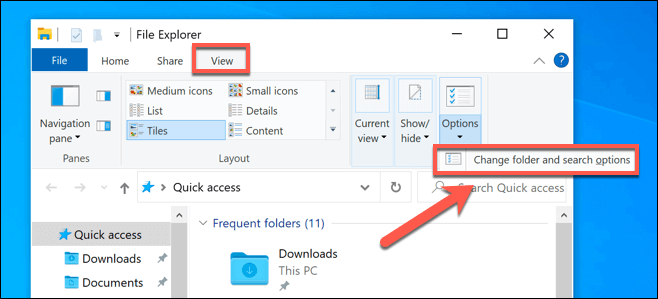
- In the View tab of the Folder Options window, brand sure that the Hide extensions for known file types checkbox is disabled, then select the OK button to save.
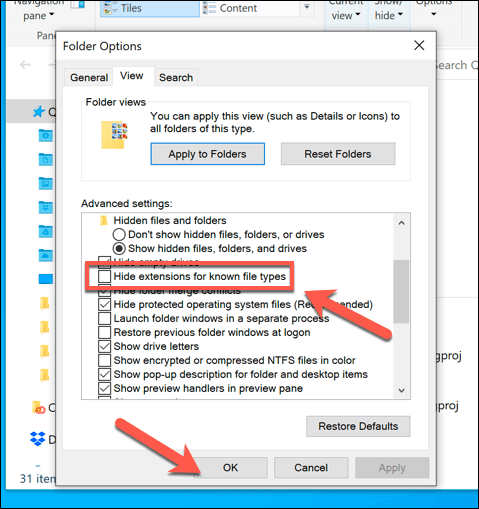
- With this setting disabled, you should at present be able to view file extensions as part of each file name in Windows File Explorer.
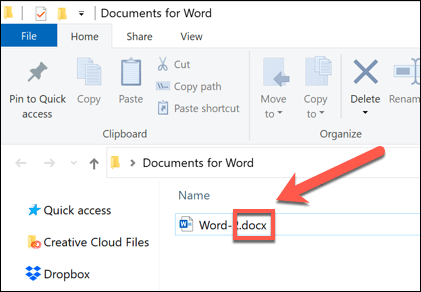
Renaming a File Extension Using Windows File Explorer
With file extensions visible, you can start changing file types by renaming the file and replacing the old extension with the new extension. For case, replacing file.txt with file.physician would turn a TXT text file to a Discussion document in the older DOC format. As the file contains text, Discussion should be able to understand and open information technology.
Yet, this only works considering software like Word is often smart enough to recognize the contents of sure files, filling in the gaps where it can to open the file. Where changing TXT to DOC would work, this wouldn't work with the newer DOCX format for Word document, as this newer file type is much more circuitous.
- If y'all withal desire to rename a file blazon this way, open Windows File Explorer, right-click and file and select the Rename option.
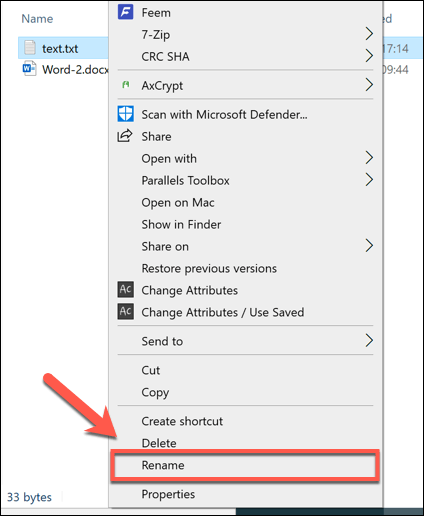
- Replace the older file extension with the new file extension, and then press the Enter central or click in the empty white space to save the changes.
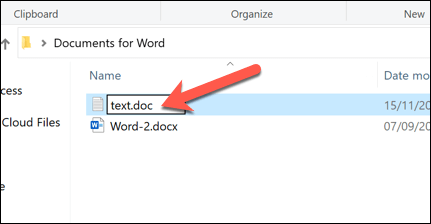
- Windows will warn you that irresolute file extensions in this manner can break the file. If you're sure y'all wish to keep, select OK to confirm.
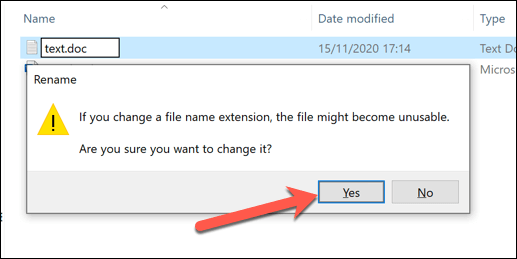
Once confirmed, the file extension will exist inverse and the file will exist listed as the new file blazon in the Type column. Depending on the file extensions used, you should at present be able to open the file. If the process hasn't worked, rename the file and return information technology back to the previous extension.
Saving a File in Another File Format
Renaming a file blazon in Windows File Explorer doesn't change the file'due south data and tin just work in sure (limited) circumstances. If you want to change a file extension properly, you'll need to salvage or export it to another format.
This works well with file types that are related. It'due south easy enough to change a DOCX file to a PDF, or a BIN to ISO, only it's more complex to modify between very dissimilar types. For instance, while a PDF tin can be exported every bit images, y'all tin can't simply rename a PDF file to the PNG format.
If the software you're using is designed to let editing, you can often save or export a file to another format by selecting File > Save or Salvage Every bit from the software card. In the Save As window, y'all should be able to change the file blazon of the saved file beneath the file name.

You'll need to cheque what file extensions are supported by the software you're using. If you desire to consign your file to a format it doesn't support, so you'll need to look for culling software or consider converting it online using a file conversion website.
Irresolute File Types Using Online Services
If you don't have the software to catechumen a file from one file blazon to another, yous can use online services to practice so. One time you lot upload the file, the remote server will convert it, assuasive you to download the file in the new format.

Yous should brand sure to only practise this with files that you're happy to share. Uploading important documents to an unknown server is probably not the wisest idea, especially if you're worried about online privacy. For non-essential files, however, using this method should exist perfectly safe to effort.
Given the huge number of different file types out there, it isn't possible to recommend i service or another. If you do want to try a service like this, however, and then try a quick Google search.
For instance, searching for convert x to y (replacing x with the original file blazon and y with the new file type you want to use) should provide you with a listing of potential results.
Managing Files in Windows 10
Once you know how to change file types in Windows 10, you can deal with software conflicts every bit they occur. You can likewise safely catechumen files from one type to some other, from music file conversions on your PC to converting PDFs to Google Docs online. If the file is in a similar format, you tin can even endeavor renaming the file extension itself.
If you're running out of space for your new files, you may need to expect at a disk space analyzer to have a bit of a clean out. At that place are ways to automatically delete files in Windows x, but if you're worried about losing of import documents or photos, be sure to look through and backup your files yourself.
Exercise non share my Personal Data.
How To Change The File Extension In Windows 10,
Source: https://helpdeskgeek.com/windows-10/how-to-change-file-type-in-windows-10/
Posted by: williamshisenturning.blogspot.com


0 Response to "How To Change The File Extension In Windows 10"
Post a Comment